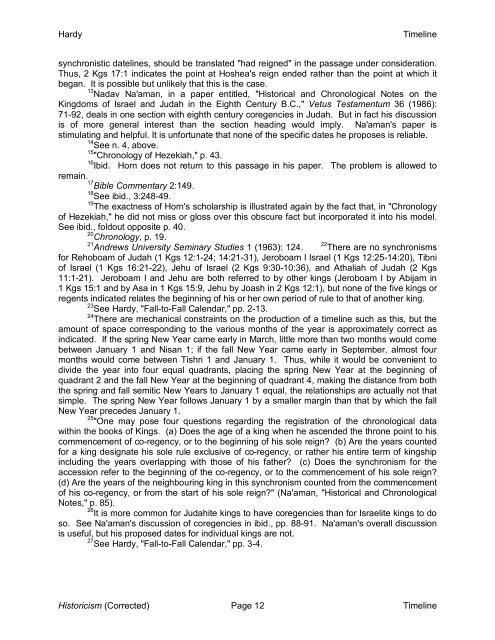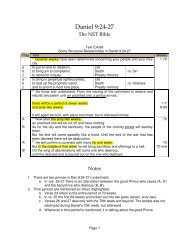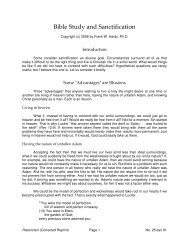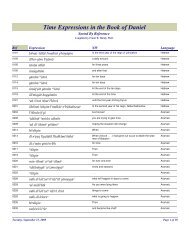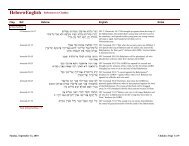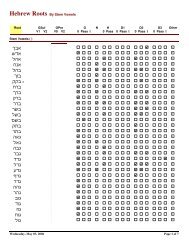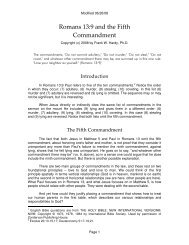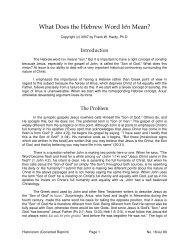A Timeline of the Kings of Israel and Judah - Historicism.org
A Timeline of the Kings of Israel and Judah - Historicism.org
A Timeline of the Kings of Israel and Judah - Historicism.org
Create successful ePaper yourself
Turn your PDF publications into a flip-book with our unique Google optimized e-Paper software.
Hardy<strong>Timeline</strong>synchronistic datelines, should be translated "had reigned" in <strong>the</strong> passage under consideration.Thus, 2 Kgs 17:1 indicates <strong>the</strong> point at Hoshea's reign ended ra<strong>the</strong>r than <strong>the</strong> point at which itbegan. It is possible but unlikely that this is <strong>the</strong> case.13 Nadav Na'aman, in a paper entitled, "Historical <strong>and</strong> Chronological Notes on <strong>the</strong>Kingdoms <strong>of</strong> <strong>Israel</strong> <strong>and</strong> <strong>Judah</strong> in <strong>the</strong> Eighth Century B.C.," Vetus Testamentum 36 (1986):71-92, deals in one section with eighth century coregencies in <strong>Judah</strong>. But in fact his discussionis <strong>of</strong> more general interest than <strong>the</strong> section heading would imply. Na'aman's paper isstimulating <strong>and</strong> helpful. It is unfortunate that none <strong>of</strong> <strong>the</strong> specific dates he proposes is reliable.14 See n. 4, above.15 "Chronology <strong>of</strong> Hezekiah," p. 43.16 Ibid. Horn does not return to this passage in his paper. The problem is allowed toremain.17 Bible Commentary 2:149.18 See ibid., 3:248-49.19 The exactness <strong>of</strong> Horn's scholarship is illustrated again by <strong>the</strong> fact that, in "Chronology<strong>of</strong> Hezekiah," he did not miss or gloss over this obscure fact but incorporated it into his model.See ibid., foldout opposite p. 40.20 Chronology, p. 19.21 Andrews University Seminary Studies 1 (1963): 124.22 There are no synchronismsfor Rehoboam <strong>of</strong> <strong>Judah</strong> (1 Kgs 12:1-24; 14:21-31), Jeroboam I <strong>Israel</strong> (1 Kgs 12:25-14:20), Tibni<strong>of</strong> <strong>Israel</strong> (1 Kgs 16:21-22), Jehu <strong>of</strong> <strong>Israel</strong> (2 Kgs 9:30-10:36), <strong>and</strong> Athaliah <strong>of</strong> <strong>Judah</strong> (2 Kgs11:1-21). Jeroboam I <strong>and</strong> Jehu are both referred to by o<strong>the</strong>r kings (Jeroboam I by Abijam in1 Kgs 15:1 <strong>and</strong> by Asa in 1 Kgs 15:9, Jehu by Joash in 2 Kgs 12:1), but none <strong>of</strong> <strong>the</strong> five kings orregents indicated relates <strong>the</strong> beginning <strong>of</strong> his or her own period <strong>of</strong> rule to that <strong>of</strong> ano<strong>the</strong>r king.23 See Hardy, "Fall-to-Fall Calendar," pp. 2-13.24 There are mechanical constraints on <strong>the</strong> production <strong>of</strong> a timeline such as this, but <strong>the</strong>amount <strong>of</strong> space corresponding to <strong>the</strong> various months <strong>of</strong> <strong>the</strong> year is approximately correct asindicated. If <strong>the</strong> spring New Year came early in March, little more than two months would comebetween January 1 <strong>and</strong> Nisan 1; if <strong>the</strong> fall New Year came early in September, almost fourmonths would come between Tishri 1 <strong>and</strong> January 1. Thus, while it would be convenient todivide <strong>the</strong> year into four equal quadrants, placing <strong>the</strong> spring New Year at <strong>the</strong> beginning <strong>of</strong>quadrant 2 <strong>and</strong> <strong>the</strong> fall New Year at <strong>the</strong> beginning <strong>of</strong> quadrant 4, making <strong>the</strong> distance from both<strong>the</strong> spring <strong>and</strong> fall semitic New Years to January 1 equal, <strong>the</strong> relationships are actually not thatsimple. The spring New Year follows January 1 by a smaller margin than that by which <strong>the</strong> fallNew Year precedes January 1.25 "One may pose four questions regarding <strong>the</strong> registration <strong>of</strong> <strong>the</strong> chronological datawithin <strong>the</strong> books <strong>of</strong> <strong>Kings</strong>. (a) Does <strong>the</strong> age <strong>of</strong> a king when he ascended <strong>the</strong> throne point to hiscommencement <strong>of</strong> co-regency, or to <strong>the</strong> beginning <strong>of</strong> his sole reign? (b) Are <strong>the</strong> years countedfor a king designate his sole rule exclusive <strong>of</strong> co-regency, or ra<strong>the</strong>r his entire term <strong>of</strong> kingshipincluding <strong>the</strong> years overlapping with those <strong>of</strong> his fa<strong>the</strong>r? (c) Does <strong>the</strong> synchronism for <strong>the</strong>accession refer to <strong>the</strong> beginning <strong>of</strong> <strong>the</strong> co-regency, or to <strong>the</strong> commencement <strong>of</strong> his sole reign?(d) Are <strong>the</strong> years <strong>of</strong> <strong>the</strong> neighbouring king in this synchronism counted from <strong>the</strong> commencement<strong>of</strong> his co-regency, or from <strong>the</strong> start <strong>of</strong> his sole reign?" (Na'aman, "Historical <strong>and</strong> ChronologicalNotes," p. 85).26 It is more common for <strong>Judah</strong>ite kings to have coregencies than for <strong>Israel</strong>ite kings to doso. See Na'aman's discussion <strong>of</strong> coregencies in ibid., pp. 88-91. Na'aman's overall discussionis useful, but his proposed dates for individual kings are not.27 See Hardy, "Fall-to-Fall Calendar," pp. 3-4.<strong>Historicism</strong> (Corrected) Page 12 <strong>Timeline</strong>


